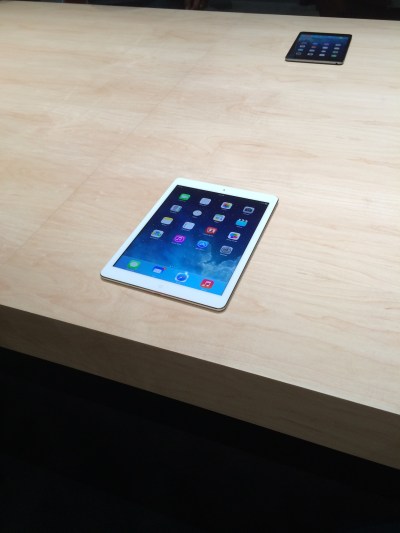
I walked into today's Apple event positive that the iPad mini with a retina display, if unveiled, would be the one iPad to rule them all. I was sure that such a device would so thoroughly upstage the 9.7-inch iPad, that there would be no shortage of folks wondering why the larger sibling even continued to exist. And actually, that proved to be prescient. Apple no longer sells the device simply called "iPad".
Enter iPad Air. The new heir apparent to the iPad throne.
When you hear about the upgraded dimensions of the iPad Air, you're undoubtedly impressed. 28 percent lighter. 20 percent thinner. 1 pound. 1 freaking pound! But it's not until you actually hold the device until what Apple has done here really registers.
I got the chance to play around with the iPad Air for roughly 20 minutes today after the event. When I first held it, it reminded me of the first time I held an iPhone 4 — or perhaps more appropriately, a MacBook Air. It's an immediate and visceral "whoa".
As someone who still regularly uses a larger iPad (technically, the "iPad 4?), it just doesn't seem possible that a company could pull off such an upgrade from one generation to the next. I'm not sure it even seems possible to perform such an upgrade at all just based on the laws of science. I mean, not only is this iPad Air absurdly thinner and lighter, it actually boasts hugely upgraded internals as well. It's just silly.
Holding the iPad Air actually feels closer to holding an iPad mini than to the regular-sized iPad. And it is closer. The iPad 4 weighed 650 grams. The (last generation) iPad mini weighed 308 grams. The iPad Air weighs 469 grams. But the other key in the device feeling more like an iPad mini is that it's not only significantly thinner, but also smaller, thanks to Apple reducing the bezels on the side of the iPad Air.
This takes a device that was 7.31-inches down to 6.6-inches while maintaining the same screen size. That's a huge reduction that's actually very meaningful when you're holding it in your hand.
And that's another key: the biggest problem myself and many others had with the original iPad is that it was hard to hold it with one hand for any extended period of time. This issue became even more pronounced when the iPad mini came onto the scene. But thanks to the size and weight reductions found on the iPad Air, this is finally a comfortable one-handed device.
So, an iPad that's insanely thinner and lighter while getting huge spec upgrades and maintaining the large screen size. It's a device that's "meant to be taken places. Handled. And really used," as Jony Ive described it in his video introduction of the iPad Air. This must be the new king of the iPads, right?
Not so fast.
Here's the strangest thing to me about today's unveilings: while the iPad Air perfected and upgraded the larger iPad in every way, the iPad mini got spec upgrades that are nearly unfathomable. How unfathomable? The iPad mini now seemingly has the exact same internals as this new iPad Air.
Think about that for a minute.
The iPad mini was previously running on an A5 chip. This new one has the just-unveiled-in-the-iPhone-5s top-of-the-line A7 chip. Yes, it skipped a generation.
Apple could have easily given the iPad mini an A6 chip and everyone would have been happy. "Want an iPad running the A7? Try the top-of-the-line iPad Air." That could have been a perfectly reasonable message. It would have still been a big upgrade for the iPad mini and presumably would have saved Apple quite a bit of cost. But Apple didn't do that.
"We want everyone to have access to all our best features," is what Tim Cook said when referring to Apple's other massive move today: making all their software — including OS X — free. But he could have just as easily been talking about these new iPads.
Buying an iPad mini is in no way a step down from buying an iPad Air. It's simply a smaller device with a slightly smaller price. Chips. Graphics. Screen. Battery life. Storage space. They're all now exactly the same on both devices. It's really just a matter of preference.
But for many of us, this is now an extremely hard choice — much harder than I thought it would be. I had thought the retina display on a slower iPad mini would trump the faster performance of the iPad with a 9.7-inch screen. Instead, we have a retina display on an iPad mini that has the same performance as a ridiculously svelte iPad with a 9.7-inch screen.
First world problem? Yes. Maybe now the quintessential first world problem. I'm torn. And I won't be the only one.
When I briefly ran into Tim Cook after the event and brought up this issue, he laughed, noting that I had another option: I could buy both.
My wallet curses you, Apple. Again.
No hay comentarios:
Publicar un comentario